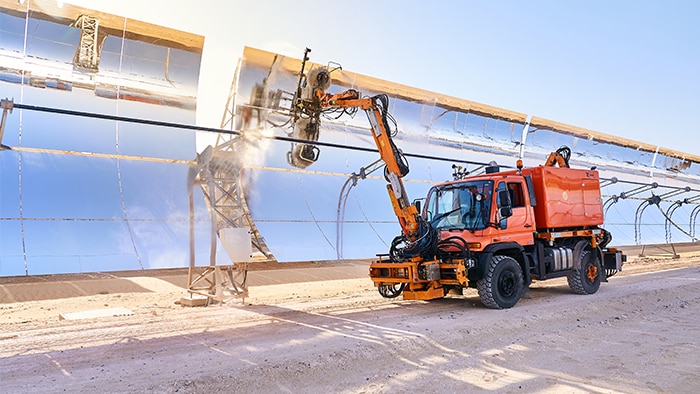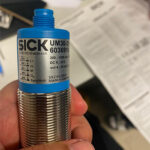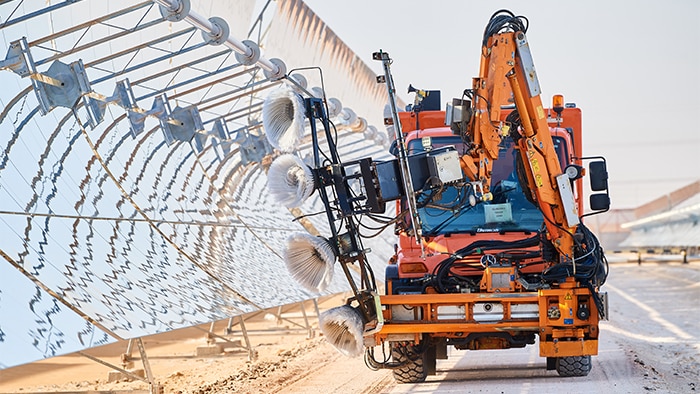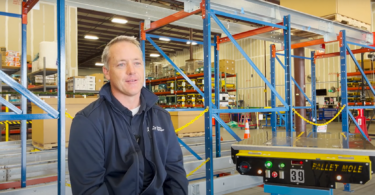SHAMS power plants hope for precision measurements in almost every stage of production
At SHAMS, a large solar power plant in western Abu Dhabi, small trucks constantly drive between the rows to clean the plant’s 250,000+ mirrors. SICK’s ultrasonic sensor UM30 measures the distance between the hydraulic arms and the parabolic mirrors, ensuring that this process at a SHAMS power plant is a graceful dance rather than a rough rinse-down.

When it opened in 2013, the SHAMS concentrated solar power (CSP) plant in western Abu Dhabi was the largest facility of its kind. To this day, the dimensions of this project are still impressive. Covering 2.5 square kilometers, SHAMS produces 100 megawatts of electricity, powering more than twenty thousand homes in the United Arab Emirates.
SHAMS is a parabolic trough concentrated solar power plant. In simple terms, this means that the power plant consists of rows of concave mirrors that reflect the sunlight and focus it onto a glass tube positioned in front of the mirror. The glass tube is filled with thermal oil, which the sunlight heats up inside of the glass tube so that it reaches temperatures of up to 500°C. The thermal oil flows to the generating station where it is used to turn water into steam, which in turn powers a steam turbine to generate electricity.

SHAMS produces 100 megawatts of electricity, powering more than 20,000 homes in the United Arab Emirates.
Complicated situations require precise, adaptable solutions
Many people assume that setting up a solar power station in a desert environment is a simple task, but this is far from the truth. In fact, one of the problems faced by the generating station is that it is in a desert environment. To keep the generating station working at capacity, it is imperative that both the mirrors and the glass tubing containing the thermal oil are clean. In a dusty environment that is prone to heavy sandstorms, this is a constant challenge. The proximity to the sea and the fog that rolls in, mixing with the dust and sand, make the job even more difficult.
A total of 258,048 mirrors and 27,648 glass tubes need to be kept clean, and that work is distributed among five cleaning trucks. Each of these trucks has two hydraulic arms that need to get close to the surfaces to ensure the best possible result. However, both the mirrors and the tubes can be easily damaged by the heavy hydraulic arms, and it is imperative that they don’t get too close. That’s the task of eight ultrasonic sensors installed on the trucks—four for each of its arms.

A total of 258,048 mirrors and 27,648 glass tubes needs to be kept clean.
Ultrasonic sensors provide precision & reliability
 SHAMS is grateful for the success from SICK's ultrasonic sensors that will prompt expanded use cases. Those factors have convinced Masdar, the owner and operator of the SHAMS power plant, to use the UM30 not just on its cleaning trucks, but for other operations in the plant as well. Precision was not the only factor that was considered. The environment around the SHAMS power plant is challenging. Faced with the intense heat of the day, the cold of the desert night, the ever-present sand and dust and the fog rolling in off the Persian Gulf, the robustness of the sensors was also vitally important. The sensors have proved that they do continue to work reliably, no matter what challenge they are faced with.
SHAMS is grateful for the success from SICK's ultrasonic sensors that will prompt expanded use cases. Those factors have convinced Masdar, the owner and operator of the SHAMS power plant, to use the UM30 not just on its cleaning trucks, but for other operations in the plant as well. Precision was not the only factor that was considered. The environment around the SHAMS power plant is challenging. Faced with the intense heat of the day, the cold of the desert night, the ever-present sand and dust and the fog rolling in off the Persian Gulf, the robustness of the sensors was also vitally important. The sensors have proved that they do continue to work reliably, no matter what challenge they are faced with.

The sensors used in the SHAMS power plant feature an LED screen.
Ease of use was another consideration. The sensors used in the SHAMS power plant come with an LED screen that allows the setup and diagnosis to be carried out directly on the sensor. That means that no other devices are needed. “Our overall experience with these ultrasonic sensors has been great. They are highly reliable and there have been no failures to date,” say Ali Al Masabai, Plant Manager at the SHAMS power station.

Each of these trucks has two hydraulic arms that need to get close to the surfaces to ensure the best possible result.
The concentrated solar power market is expected to grow from $41.68 billion in 2021 to $119.52 billion in 2028, an annual growth rate of 16.2%, and SICK will be there to help such plants operate more efficiently!
Want to learn more about this application?





